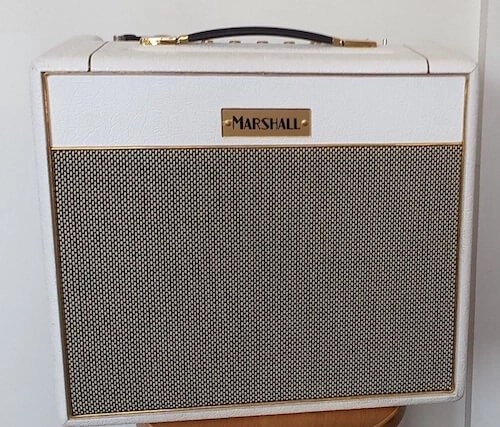
For countless fans worldwide, the definitive image of an ear-shattering rock and roll show is the wall of Marshall amps, notably the Super Lead series.
The famous Marshall stack, with a single 100 or 50-watt head perched atop two speaker cabinets, graced the stages of virtually every rock and metal band from the sixties to the modern era.
So we know they are loud and powerful… But are they worth having in your house?
Yes! Marshall amps are great if your style of playing is classic rock and heavy metal. With a distinctive sound, sparkling high notes, aggressive midrange, and thumping lows, these amps will ensure you get a powerful sound for a relatively competitive price.
Something for first-time Marshall buyers to be aware of is that Marshall amps have a very particular sound.
Marshall’s closest competitor, Orange amplifiers, have a fizzier, more compressed distorted tone with less grunt and roar than Marshalls do.
Orange amps will get you within grabbing distance of classic rock tones.
They are mostly loved by shredders and guitarists using de-tuned instruments.
That is because the fizzier tone of an Orange amp helps add definition to the guitar’s lower frequencies.
However, Marshall amps get closest to the classic rock and metal tones still playing on FM radio worldwide.
Similarly, Marshall’s amps won’t provide the sparkling, jangling clean tones of a Fender or Vox amp, no matter how low your gain is.
The amp’s tonal palate is far from neutral.
Fender amps are famous for effectively sounding like a louder version of your unplugged guitar, but Marshalls color and shape your tone.
Marshall amps aren’t intended as pedal platforms.
If you want to do rock, dirty blues, or metal, Marshall has you covered, but for ultra-clean jazz or rockabilly, you may want to look at Fender.
Here is a quick overview of the Marshall Amps
| Sound | 10 |
| Looks | 10 |
| Price range from $1,699.00 to $2,350.00 | 7 |
| Build Quality | 9 |
My Personal Experience With Marshall Amps
I play the Marshall SV20C, a small combo amp designed to replicate the classic Marshall Super Lead tone.
Ironically, considering the sole aim of the Super Lead was ear-shattering volume. The SV20C is built to produce Marshall roar and crackle at lower volumes.
My SV20C, at first glance, looks nothing like the Marshalls I’ve become familiar with over the past fifteen years of gigging.
Instead of black Tolex and the iconic white cursive faceplate, this amp is brilliant white with gold trim!

Like most of my best guitar purchases, I bought this amp slightly by accident.
I was in my local guitar shop replenishing my supply of strings and picks (where picks decide to go in between uses will forever be a mystery), and a white Marshall caught my eye.
I returned to the store with my trusty, tour-hardened vintage Les Paul Standard, and gave this eye-catching amp a whirl.
Did it sound as good as it looked? No, it did not. Why? because I was using it wrong!…
Upon plugging in, I immediately realized that this amp had not one, not two, but four inputs for the lead.
Each represents a high or low-powered option for each of the Marshalls’ two channels:
- the “high treble” channel, and
- the “normal” channel.
The high treble channel is exactly that: jangling treble. It’s actually too bright for my liking, even with the bass EQ turned all the way up.
When I tried the normal channel, it felt like an over-correction of the high treble channel, with a flabby, muddy sound.
None of my Les Paul attack or character came through the speakers.
I felt disappointed…
Maybe Marshall, the unassailable home of big, British rock and roll sounds, had finally dropped the ball.
That’s when a store clerk walked over, patch cable in hand, to inform me that on the old-school non-master-volume Marshall Super Leads, standard practice was to “jump” the two channels, blending the tones of each channel.
Fascinated, I obliged, placing one end of the little cable into the bright channel, and the other into the normal channel.

Following Hendrix’s lead, I dutifully cranked every knob on the EQ to 10, and used the blending channels as a rudimentary tone control.
First, the normal channel goes up. Less muddy, but none of the Marshall roar I was hoping for.
A slight increase in the bright channel, only to about a third of the volume in the normal channel, and suddenly this pint-sized powerhouse roared to life.
All the crackling, white-hot lead guitar tone of my favorite records came pouring out of the amp’s 10-inch speaker.
With no effects in tow, grinning as I adjusted the relative volumes of each channel, I was drawn irresistibly to certain classic rock riffs:
- “Back in Black” sounds like Angus himself.
- “Whole Lotta Love” stutters and wails just like it does on Live at the Royal Albert Hall.
- Rolling back the volume knob on my Les Paul reins this amp back to clean territory, and gentle fingerpicking and blues turnarounds sound sweeter than ever.
- Rolling it back up to 10 and switching to the neck pickup, a la Gary Moore, unleashes wailing lead guitar tone.
I was stunned upon getting home to realize that these lashings of loud rock and roll tone were coming through the amp’s low-powered five-watt setting.
I switched to the full-bore twenty watts, and this Marshall really kicked into gear.
It was a similar tone to five watts, but deeper, more commanding.
This little Marshall was incredibly loud.
Even with the channel volumes no higher than halfway, it rattled the windows in my apartment.
I’ve since played it with a drummer both at rehearsal and in a small club (about 300 capacity), and never needed to play any higher than halfway.
Just for fun, I cranked the volume at the full twenty watts, and even though the amp sounded amazing, it simply produces far more volume than I could possibly need at home.
Are Marshall amps tube or solid-state?
Marshall produces both tube and solid-state amplifiers. While their tube amplifiers are for those paying classic rock or heavy metal, the solid-state amps are more for the genres where clean playing at high volumes is prized, such as jazz.
The classic Marshall tone comes from the amplifier tubes.
In the 1960s and 1970s, Marshall amps used EL34 or 6550 tubes in their flagship Super Lead range.
Other Marshall amps tubes are ECC83 and 6L6, but many consider the EL34 to be the tube that delivers the classic Marshall sound.
However, with a brand as old and powerful as Marshall, there are many variations of the Marshall amplifier on the market.
Related: What are the different types of marshall amps
Some Marshall amplifiers, such as the Valvestate series, use a combination of solid-state and tube technology.
Marshall’s MG Series is a purely solid-state line of amps, while the Code series provides digital amp modeling.
Generally speaking, guitar players looking to emulate the classic Marshall tone, whether that’s the Super Lead or high-gain JCM series, should turn to Marshall’s tube amplifiers.
Although Marshall has dabbled in solid-state and digital amps over the years, the core of their range remains the classic Marshall tube amp.
Although Marshall’s solid-state amplifiers can be good in their own right, they simply won’t sound like a classic Marshall.
While most rock players swear by the Marshall tube amplifier, it’s worth noting that in genres where clean playing at high volumes is prized, such as jazz, a solid-state amp may well be better suited.
Solid-state amplifiers don’t distort at high volumes the way tube amplifiers do.
You should also be aware that tube amps are more fragile than solid-state amps.
This is because the tubes tend to break when dropped or banged.
What’s The History Of Marshall Amp
The Marshall Super Lead was the world’s first amplifier built for distortion and overdrive.
Previous amplifiers, such as the Fender or Vox, prioritized high-fidelity sound reproduction to produce a clean guitar sound at the highest possible volume.
This was all good and well for The Beatles or London’s thriving jazz scene, but younger guitarists wanted a more aggressive tone than was available using the technology of the 1960s.
Marshall Amplification was founded in 1962 by Jim Marshall, an English drummer.
The likes of the Who’s Pete Townshend and Deep Purple’s Ritchie Blackmore frequented his drum shop.
These pioneers of hard rock guitar complained that the guitar amplifiers then available to them lacked the power, volume, and crunch they wanted.
Jim Marshall responded by building a high-wattage amplifier using American military surplus preamp valves.
To accommodate the increased wattage of these new amps, he used four twelve-inch speakers rather than the more conventional one or two.
Before the volume control, the higher-gain valves and resistor filter allowed the newly built amplifier to overdrive and distort at (relatively) lower volume than anything made before.
The Marshall roar was born and quickly adopted by every serious rock guitarist in London.
The JTM 45, Marshall’s first amplifier, was first released in 1963 and quickly became one of the most sought-after amplifiers in England.
Fast forward to six years later. Jimi Hendrix took to the stage at Woodstock 1969 in the early hours of the morning.
Hendrix wielded his white Stratocaster like a weapon.
Playing it with his teeth, setting it on fire, and serenading the masses with never-before-seen guitar heroics.
He blended jazz, blues, and high-octane rock and roll before the largest crowd rock and roll had ever seen.
Hendrix’s sizzling, roaring guitar sound came courtesy of a Marshall Super Lead stack.
The sound of rock and roll was forever changed.
Conclusion
Marshall amps are classic for a reason.
They’re the sound of almost every classic rock guitar hero, from the 60s to the modern era.
The new SV20C provides the iconic sound of the Marshall Super Lead in a smaller package, but don’t be fooled by its diminutive size. With only twenty watts and a ten-inch speaker, you’ll be rattling the walls with a searing rock guitar tone in no time.
